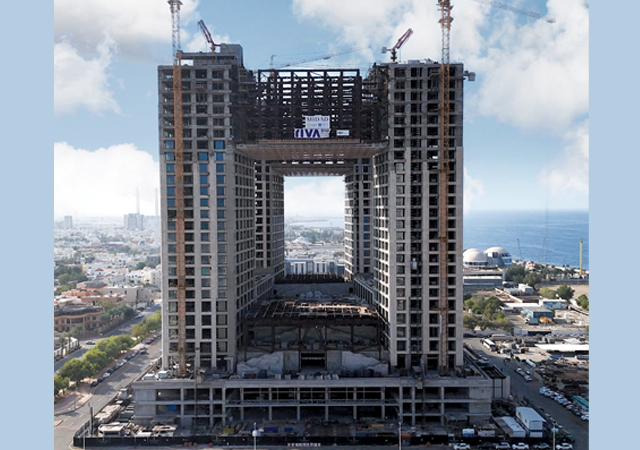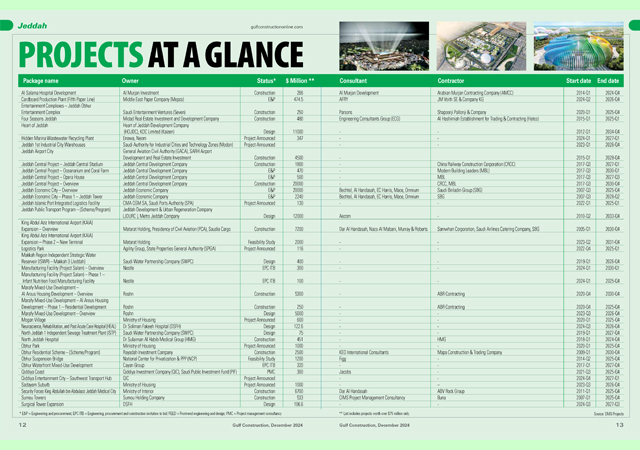
 Santoro ... the time to act is now.
Santoro ... the time to act is now.
The built environment encompasses all constructed spaces where human activities take place – where people live, work, learn or play – and is responsible for 40 per cent of energy-related global carbon emissions and over 30 per cent of global final energy use. This sector also consumes nearly half of the world’s natural resources1.
With the global urban population expected to rise from 55 per cent today to 80 per cent by 20502, the demand for urban infrastructure is skyrocketing. Remarkably, firms are constructing the equivalent of a city the size of Paris every week3.
In 2020, the built environment and mobility sectors (which include construction, transport and related infrastructure) were responsible for 55 per cent of global material demand – amounting to 59 billion metric tons. By 2060, total resource extraction could increase by almost 60 per cent compared to 2020, with the built environment and mobility sectors driving this surge4.
 |
|
Building layer levels and their life span. |
In mature economies, about 80 per cent of the buildings already constructed will still be in use by 20505, while emerging markets like Africa have yet to construct some 70 per cent of the building stock needed by 20506.
The Circularity Gap Report 20247 reveals that embracing circular economy solutions has the potential to reverse the breaching of planetary boundaries and reduce global material extraction by a third while simultaneously addressing social inequalities. Additionally, the Global Resources Outlook 20244 (GRO24) underscores that decisive actions rooted in circular economy principles can drive systemic decarbonisation and lead to a 30 per cent reduction in material demand in the built environment, all while fulfilling essential human needs.
However, how is it possible to ensure the world is on the correct path and making the right decisions?
WE CAN ONLY MANAGE WHAT WE MEASURE
Implementing consistent circularity measurements and adopting a standardised approach presents numerous advantages for businesses, governments and society. Assessing circular economy performance equips organisations with invaluable insights, enabling them to optimise resource use, minimise waste, lessen environmental impacts, stimulate innovation and generate long-term value for stakeholders. Simultaneously, it fosters the development of resilient and adaptive urban environments for future generations. Measuring circularity empowers the whole built environment value chain to gauge the circularity levels of the buildings that companies own and people use and help to make informed decisions to enhance their performance. By integrating circular economy principles, stakeholders can position themselves for sustainable growth in a world with increasingly constrained resources.
To achieve this, it is essential to establish a unified language across the industry, finance and government sectors. This will facilitate the development of strategies, measuring progress in circularity and aligning on a set of standardised circular metrics.
CTI FOR BUILDINGS
Although companies have made considerable efforts to improve the circularity of buildings, a complete set of indicators that can reliably measure building circularity is still under development and differs significantly depending on the geographical and environment context.
In response to this need, the World Business Council for Sustainable Development (WBCSD) initiated an extensive study in 2022 focused on defining the essential elements required to measure the circularity of buildings through the use of the Circular Transition Indicators (CTI)8 framework. Businesses worldwide selected CTI as a starting point because of its simplicity, objectivity, inclusiveness and quantitative rigour, making it applicable across industries of all sizes, at various stages of the value chain and across geographies.
Designed by business, for business, CTI offers companies a standardised language to guide internal decision-making and communicate effectively with key stakeholders. Published under the Creative Commons and widely accessible, CTI is an inclusive framework that considers material, water and energy flows, critical raw materials, financial indicators and impacts on climate and nature – setting a robust foundation for work in the built environment. WBCSD has developed CTIs for fashion, chemicals, electronics and now buildings.
WBCSD published the results of the study of the key elements to consider to achieve circular buildings in its Measuring Circular Buildings: Key Considerations9 white paper. The paper concludes that measuring circularity in the built environment requires a definition of scope for both the lifecycle stage of buildings and the shearing layer of the elements considered, including material, energy and water flows, the circularity of design and the broader impacts on nature, society and business value.
To maximise the impact of the assessment, it is essential to clearly define its scope before initiating the process. In general, it is important to collect data at the building layer level (structure and site, skin, space plan, services and social) and cover the entire life cycle of the building, capturing as much detail as possible. That said, assessing individual layers at specific stages of the building’s life cycle can also provide significant value, depending on the scope established by the stakeholders at the outset.
Following this study, WBCSD members and other stakeholders identified as a priority the need for a framework capable of consolidating all relevant information in one place, applicable to any building type – whether new, existing or slated for demolition and whether residential, commercial or other types. While there are various solutions to measure these key considerations in the current market, they do so separately and often for specific building types. This creates confusion and fragmentation as each solution employs different metrics, indicators, terminologies and data collection methodologies, making effective communication and collaboration challenging.
ACTIONABLE STEPS FOR PROGRESS
WBCSD, with the support of British multinational professional services firm Arup and the collaboration of its members and partners, is developing a unified methodology that allows stakeholders to comprehensively measure the circularity of buildings. This methodology will provide a standardised approach and terminology, facilitating collaboration and information exchange along the value chain to promote circular economy practices.
The framework will incorporate both quantitative and qualitative data and enable stakeholders to evaluate their decisions for material selection and reuse, design and their broader economic, social and environmental impacts. By providing clear, concrete data, stakeholders can visualise the outcomes of their decisions and reconsider them, if necessary, before implementation.
Given the complexity of this endeavour, WBCSD and its partners have adopted a phased approach.
The initial version of the framework will primarily concentrate on measuring material flows and design, incorporating renewable energy metrics from the Circular Transition Indicators v4.0. WBCSD will unveil this new version in May 2025 at the World Circular Economy Forum in Brazil. The organisation, along with its partners, will pursue further research and stakeholder engagement on additional key considerations over the coming years, contingent upon market readiness and data availability.
With WBCSD soon publishing CTI for Buildings, material flow measurement will include tracking the inflow and outflow of materials, analysing their quantity and type (whether virgin, reused or recycled) and assessing both potential and actual material recovery.
Design measurement, on the other hand, involves evaluating the potential to reuse space, enhance the building’s use and adaptability, extending the building’s lifespan and facilitating dismantling and disassembly, alongside assessing material efficiency. It will ultimately influence the material flows and have an impact on carbon dioxide equivalent emissions (CO2e – the number of metric tons of CO2 emissions with the same global warming potential as one metric ton of another greenhouse gas).
These three key levers for circularity, sourcing (circular inflow), design (potential recovery) and actual recovery combine into one Material Circularity score designed to forge a crucial link between material flow and design. This metric measures the efficiency of the use of materials in a system, particularly in a way that maximises their value and minimises waste. This is the core metric in CTI v4.0.
THE PILOT PHASE
WBCSD is leading a pilot phase of this initiative, with the support of Arup and Arcadis, for expected completion by January.
They are performing the assessment, on entire buildings or specific layers, with the main goal of evaluating whether the methodology effectively covers all critical aspects. Furthermore, it aims to explore how circularity measurement can tangibly shape decision-making processes and ultimately contribute to developing a more sustainable built environment.
A call to action for collaboration in developing a standardised framework
From the analysis provided, it has become clear that it is necessary to have a unified and consistent approach to measuring sustainability and circularity. Existing methods can vary widely, causing confusion and making it harder to achieve meaningful change at a large scale.
To tackle this, industry leaders, policymakers, researchers and stakeholders throughout the built environment value chain are invited to join WBCSD in developing the CTI for Buildings. This comprehensive and standardised framework aims to bring together different metrics, streamline data collection and offer a clear way to assess circularity across various building types and regions.
A standardised approach will help the industry track progress more effectively, set benchmarks and make smarter decisions that align with long-term sustainability goals. It will also boost transparency and accountability, ensuring that circular economy strategies provide real value for people, businesses and the environment.
By working together, we can build a solid framework that both simplifies the complexities of the built environment and speeds up our shared journey toward a more sustainable and regenerative future. The time to act is now – let’s collaborate to create a standardised approach that leads to measurable, positive change.
References
- https://globalabc.org/news/globalabc-releases-2022-global-status-report-buildings-and-construction#:~:text=An%20estimated%2070%%20of%20the%20African%20building%20stock%20in%202040
- https://climatechampions.unfccc.int/visualizing-the-material-impact-of-global-urbanization/
- https://www.unep.org/news-and-stories/press-release/un-plan-promises-massive-emission-cuts-construction-sector-most
- https://www.unep.org/resources/Global-Resource-Outlook-2024
- https://www.weforum.org/stories/2022/11/net-zero-cities-retrofit-older-buildings-cop27/
- https://globalabc.org/news/globalabc-releases-2022-global-status-report-buildings-and- construction#:~:text=An%20estimated%2070%%20of%20the%20African%20building%20stock%20in%202040
- https://circulareconomy.europa.eu/platform/sites/default/files/2024-01/65ae7d516defe92cc1988a47_CGR%20Global%202024%20-%20Executive%20Summary.pdf
- https://www.wbcsd.org/resources/circular-transition-indicators-v4/
- https://www.wbcsd.org/resources/measuring-circular-buildings/
This article was originally published on WBCSD’s website: Measuring the Circularity of Buildings: A Call to Action on a Standardized Framework on 3 October 2024














.jpg)














































.jpg)

